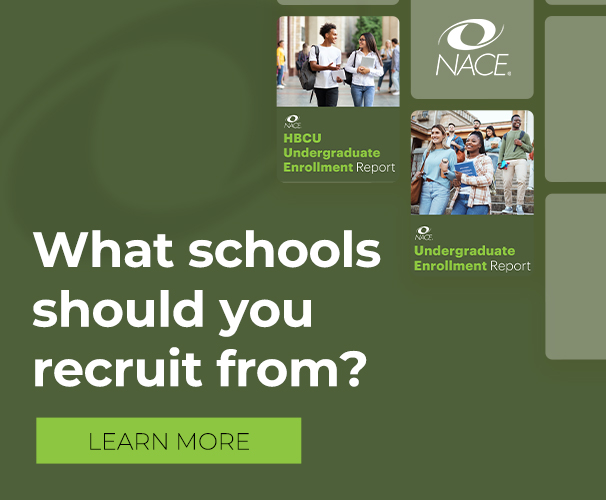Among the recommendations in the recent research report Recruiting for Equity at HBCUs and Beyond: Current Practices and Pitfalls for employers to develop greater equity in recruiting are for them to build relationships with Black colleges. How can employers create long-lasting, mutually beneficial partnerships with HBCUs and PBIs?
Dr. Terrell Strayhorn, professor at Illinois State University and visiting scholar in the School of Education at Virginia Union University, where he serves as director of the Center for the Study of HBCUs, says these relationships should take into consideration several factors.
“Echoing sentiments from the report, I strongly encourage employers to prioritize establishing mutually beneficial relationships with HBCUs and PBIs,” explains Dr. Terrell Strayhorn, who co-authored Recruiting for Equity at HBCUs and Beyond.
“Black educational institutions have so much to offer; so, too, do employers that will greatly benefit our faculty, staff, students, and alumni.”
Before reaching out, Dr. Strayhorn advises employers to:
- Look around—The first step is for employers to look around their physical vicinity, their company, and their networks, as well as online, to identify by name the HBCUs and PBIs with which they might work. Employers can use the NACE report and its appendixes to get started. They should keep in mind that they don't have to limit their search to institutions in their local area. They can think creatively about the power and potential of online webinars, trainings, collaborations, and internships, especially with the meteoric rise in remote work options.
- Lean in—To lean in, employers should make a good faith effort to get to know these “national treasures,” our 101+ HBCUs and other PBIs, just as they are. See the genius, beauty, and excellence they bring. Like other institutions, they employ “rockstars” and unsung heroes. All deserve celebration and reward. What is the institution's history and how has it changed over time? Who are its people—its president, provost, faculty, students, and famous alumni? What is the curricular emphasis today and how does that align with the work, scope, and impact of the company? What do both sides need and how can they help each other? These are not questions employers can answer on their own—they should seek, value, and respect the input of the HBCUs and PBIs.
- Level up—After looking around and leaning in with understanding, the employer should be sure to level up and reach out with clear, mutually beneficial goals, ideas, and plausible plans in mind. Culturally sensitive, socially conscious, anti-racist leaning in will help the organization realize the importance of “leveling up” when connecting with institutions that have been marginalized, overlooked, and downplayed for far too long. So, if the employer wants to meet with the HBCU president, it should be sure to offer its president. If it desires time with the vice president over human resources or internships, it should be sure to level up and send its VP as well. A former HBCU provost and senior vice president, Dr. Strayhorn recalls his staff interpreting a company not matching levels of representatives with the HBCU’s as dismissive, disrespectful, and offensive, even though he understood that executives’ lives are busy and hurried. Still, employers should remember that every action has a reaction and an inadvertent mismatch could compromise the possibility of partnership.
Dr. Strayhorn says that when reaching out to establish a relationship, it is important for employers to be real, be authentic, and be open. They can do so by:
- Demonstrating their pre-work by acknowledging from the very beginning that they seethe HBCU or PBI as an equal and valuable partner, with just as much to offer as they stand to gain.
- Celebrating the history and contributions of Black institutions with accurate and specific examples.
- Finding out how many HBCU graduates they have employed, interned, promoted, and/or converted over time and presenting these details in the conversation. Employers should mention that they want to increase or sustain those numbers, but acknowledge that they simply can't do it without the HBCU or PBI.
- Knowing people's roles, titles, and place within the institution. Employers should observe how the HBCU or PBI representatives greet one another and, when in doubt, employers should demonstrate their knowledge and respect for the HBCU or PBI representatives’ positions by using them in any references.
“After making the case for a partnership,” he says, “the employer should stop and listen to what they need and want, and ways it can accelerate achievement of their goals. At this point of the conversation, the employer should do more listening than talking and not be afraid to take notes and ask for clarification.”
On the other hand, representatives of the employer should be prepared to answer questions about their organization, its work in the DEI area, and its intentions and vision for this partnership. Potential questions include:
- Have you worked with any HBCUs or PBIs in the past and, if so, in what ways?
- Do you currently employ or intern any HBCU or PBI students or graduates?
- What do we stand to gain or benefit from this partnership?
- What are the expected, mutually agreed upon deliverables, timeline, and resources for this partnership?
Beyond the talk, there are things an employer can do to demonstrate its commitment to this relationship, that it is in it for the long haul, and wants to develop a true partnership instead of a performative one. Doing so is important because, as Dr. Strayhorn explains, many companies and organizations “go in” to partner with HBCUs in short, one-time, unidirectional activities—a single workshop, a one-time gift, or solitary scholarship.
“Let's be clear,” he notes, “they can be helpful and certainly have a place. But, if employers want to demonstrate deeper, long-term commitment to true partnership, I think they would do well to state that up front; prepare for a marathon, not a sprint; and be creative about laying out a partnership plan that spans over time, marked by progressively greater commitments, investments, and involvements.”
For instance, Dr. Strayhorn says a multi-year partnership might jumpstart with a kick-off event, one-time internship or scholarship, plus a press campaign that builds energy around the new initiative.
“After six months, the employer might deepen ties by highlighting achievements of the inaugural scholarship recipient, make another award or two, while also hosting a physical or virtual event, such as a happy hour, webinar, or town hall that brings the company and HBCU/PBI communities together,” he explains.
“Buy-in leads to tie-in, where strong bonds sustain partnerships for the long haul.”
These ties are strengthened by elements that contribute to mutually beneficial relationships between employers and HBCUs/PBIs, including:
- Trust;
- Honesty;
- Mutual respect;
- Values alignment;
- Open communication; and
- Collective impact.
Lack of these and other factors—such as inadequate resources (human, fiscal, or otherwise), incompatibility, or failure to deliver or meet expectations without explanation—can lead to the partnership breaking down.
Another essential element is flexibility.
“Employers should not go in with a script of what must happen, when, where, and to what extent,” Dr. Strayhorn advises.
“They can't bake this cake on their own—they can bring some ingredients, their favorite toppings, and necessary tools or utensils. However, they should be open to changing the recipe, mixing in their unique perspectives, and even using or learning about the HBCU’s or PBI’s preferred tools, methods, and ways of getting things done.”
He urges employers to “appreciate the value of diverse epistemologies or ‘ways of knowing,’ especially during the looking around and leaning in phases of building relationships.” Dr. Strayhorn explains that there is enormous value in quantitative data—numbers, tallies, statistics, trends, and predictions—that can be visualized through charts, graphs, and scores.
“But,” he continues, “there's also unquantifiable value in qualitative data—words, stories, vignettes, pictures, and documents—which have long-since been highly prized sources of knowledge, wisdom, fact, and understanding in communities of color.”
To incorporate this combination of data sources into its approach to partnerships, the employer can, for example, determine how many students are enrolled at the HBCU or PBI and how many have earned internships in the last three to five years. Furthermore, the employer can listen to the experiences and needs of students and others in the campus community. The employer can then help the institution and, by extension, its students, for example, by offering more internship opportunities, higher pay, and/or free career training or development workshops.
“Certainly,” Dr. Strayhorn adds, “the employer will gain more diverse and qualified job applicants, interns, or conversions, but the students will benefit too and that's vitally important for long-term success.”






